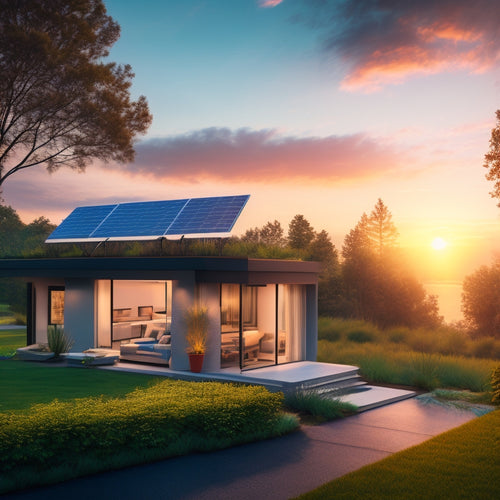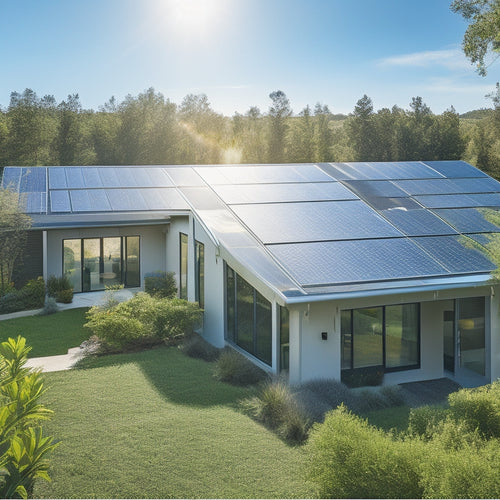
Urban Home Energy Independence: What's Possible Now
Share
You can now change your urban home into a self-sustaining haven, leveraging state-of-the-art solutions to overcome space constraints and maximize energy independence. Community solar programs and innovative designs enable reliable power supply, even in densely structured environments. High-efficiency solar panels and energy storage solutions optimize energy production and management. You can calculate your roof's solar potential, choose the right panels, and maneuver installation costs and incentives. By embracing these advancements, you'll be closer to achieving energy independence - and there's still more to investigate on your path to a sustainable urban home.
Overview
- Urban homes can achieve energy independence through community solar programs, energy storage solutions, and high-efficiency solar panels.
- Innovative designs and multi-functional spaces enable energy generation in space-constrained urban homes.
- Effective energy management and monitoring are crucial to maximize the benefits of energy storage systems in urban homes.
- Incentives like tax credits, financing options, and local regulations can significantly offset the costs of energy-efficient upgrades in urban homes.
- With the right technology and planning, urban homes can reduce their reliance on the grid and enjoy greater energy independence.
Harnessing Urban Solar Potential
Since the urban environment is often characterized by dense building structures and towering skyscrapers, it's easy to assume that utilizing solar energy is a rural or suburban luxury. However, you can still utilize the power of the sun in the city.
With advancements in Energy Storage Solutions, community solar programs can now store excess energy generated during the day for later use, ensuring a reliable power supply. Community solar programs, for instance, allow you to invest in a shared solar array and receive a proportionate amount of electricity.
Renewable partnerships between urban agriculture projects and solar developers can also provide a win-win solution. With policy support and energy literacy initiatives, you can take advantage of solar education programs to learn more about sustainable design and microgrid development.
Overcoming Space Limitations
You've examined ways to employ urban solar potential, but now it's time to tackle the elephant in the room: space limitations. Urban homes often face constraints on available space, making it challenging to integrate energy-generating systems.
However, innovative designs and modular systems, such as high-efficiency solar charging solutions, can help overcome these limitations. In addition, advanced features like built-in monitoring and control can provide real-time energy observations, allowing for more efficient energy management.
Consider multi-functional spaces that combine living areas with energy-efficient appliances and vertical gardens. Rooftop gardens can also provide additional space for solar panels or greenery.
If individual rooftops aren't feasible, investigate community solar initiatives that allow you to invest in a shared solar array.
Don't let urban zoning restrictions hold you back – research innovative solutions that work within existing regulations to achieve energy independence.
Solar Panel Options for Roofs
When considering solar panel options for your roof, you'll want to assess how much space you have available, as roof size will notably impact the number of panels you can install.
You'll also want to investigate high-efficiency panel options, which can maximize your energy output per square foot, such as monocrystalline panels that offer high efficiency ratings ranging from 15% to 22%.
Additionally, selecting an inverter with an efficiency rating above 95% is vital to optimize energy production.
You'll need to factor in installation costs, which can vary depending on the type and quality of equipment, as well as the complexity of the installation process.
Roof Size Matters
Measure your roof's potential to go solar by calculating its available space.
You'll want to evaluate roof orientation, as south-facing roofs receive the most sunlight. Verify you have enough space for peak panel placement, considering obstructions like vents, skylights, or chimneys.
A larger roof doesn't always mean more energy production, as panel efficiency and placement play a significant role. Calculate your roof's size in square feet and determine how many panels you can fit comfortably.
Consult with a solar expert to determine the ideal panel configuration for your roof. By maximizing your roof's space, you'll be one step closer to achieving energy independence.
Panel Efficiency Gains
With your roof's potential for solar energy harnessed, it's time to investigate the various solar panel options that can maximize energy production. You're looking for the most efficient panels to get the most out of your available roof space. Advances in panel technology have led to significant efficiency advancements, and you'll want to take advantage of these gains.
| Panel Type | Efficiency Range | Typical Cost per Watt |
|---|---|---|
| Monocrystalline | 18-22% | $2.50-$3.50 |
| Polycrystalline | 15-18% | $2.00-$3.00 |
| Thin-Film | 7-14% | $1.50-$2.50 |
| Bifacial | 18-22% | $3.00-$4.00 |
| Perovskite | 20-25% | $3.50-$5.00 |
Now that you've got a sense of the panel options, you can make an informed decision about which ones will best fit your energy needs and budget.
Installation Cost Factors
Several factors will influence the overall cost of installing solar panels on your roof, and understanding these variables is vital to planning your energy independence project.
You'll want to assess financing options, installation incentives, and local regulations that can impact your upfront costs. The contractor you select can also affect the final bill, so it's important to choose a reputable and experienced installer.
Additionally, technology advancements and energy audits can help optimize your system's performance and reduce maintenance costs over time.
Don't forget to investigate utility partnerships that may offer special rates or rebates for solar-powered homes.
Energy Storage for Urban Homes
About 80% of urban homes rely on the grid for electricity, leaving them vulnerable to power outages and rate hikes. You can break free from this reliance by investing in energy storage for your urban home.
Advances in battery technologies have made it possible to store excess energy generated by your solar panels or wind turbines during the day for use at night or during power outages. Effective energy management is essential to maximize the benefits of energy storage.
You'll need to monitor your energy usage and adjust your storage system accordingly. With the right energy storage solution, you can reduce your reliance on the grid and enjoy greater energy independence.
Grid Tie or Off Grid Systems
Beyond the energy storage system itself, you'll need to decide how it integrates with the grid: as a grid-tie system or an off-grid system.
A grid-tie system allows you to sell excess energy back to the grid and draw from it when needed, providing a reliable backup power source. Off-grid systems, on the other hand, provide complete energy independence, but require careful energy management to guarantee you're producing enough power to meet your needs.
When making your decision, consider factors such as system integration, cost analysis, and technology advancements. Be aware of regulatory challenges and community initiatives that may impact your choice.
Incentives for Urban Homeowners
As you steer the path to urban home energy independence, you're likely to find that incentives for urban homeowners can be a significant catalyst for change.
You can take advantage of tax credits, financing options, and rebate programs to offset the cost of energy-efficient upgrades. Community solar programs allow you to benefit from shared solar arrays, while energy audits help you identify areas for improvement.
Local regulations and utility partnerships can also provide incentives, such as reduced rates or priority connections. Green loans offer financing options specifically designed for energy-efficient projects.
Frequently Asked Questions
Can I Install Solar Panels on a Historic Home or Landmark Building?
You can install solar panels on a historic home or landmark building, but you'll need to maneuver historic preservation rules and solar regulations, ensuring a discreet installation that respects the property's original character.
How Do Urban Solar Panels Affect Property Resale Value?
You're wondering how urban solar panels impact property resale value. Good news: they often enhance it! Solar panel incentives and energy efficiency upgrades can increase your home's attractiveness, making it more desirable to potential buyers, which can lead to a higher resale value.
Are There Any Urban Solar Solutions for Renters or Shared Spaces?
Coincidentally, you're not alone in seeking urban solar solutions for renters or shared spaces! You can investigate community solar programs, where multiple individuals invest in a shared solar array, or rooftop gardens that integrate solar panels, providing a communal approach to renewable energy.
Can Urban Solar Energy Systems Be Connected to Smart Home Devices?
You can seamlessly connect your urban solar energy system to smart home devices, enabling real-time monitoring and control through solar integration with smart technology, giving you autonomy over your energy usage and maximizing your freedom.
Do Urban Solar Panels Require Frequent Cleaning and Maintenance?
As you bask in the liberty of utilizing solar power, you'll wonder: do urban solar panels require frequent cleaning and maintenance? Fortunately, you'll find that cleaning frequency depends on location and climate, and maintenance tips like regular inspections and debris removal keep your system running smoothly.
Ready to Buy
You've got the power to break free from the grid! With the right solar panel setup, energy storage, and incentives, urban home energy independence is within reach. It's not a drop in the bucket, but a tidal wave of possibilities. You can slash your energy bills, reduce your carbon footprint, and enjoy the satisfaction of being your own energy boss. The future is bright, and it's shining right on your rooftop - literally!
Related Posts
-

The Future of Residential Energy Storage
The future of residential energy storage looks promising and cost-effective for you. With lithium-ion battery prices ...
-

Installing Metal Solar Roofs for Maximum Energy Efficiency
Installing metal solar roofs can drastically enhance your home's energy efficiency and durability. These roofs withst...
-

Top Solar Powered Camping Fans for Camping Enthusiasts
If you're a camping enthusiast, a solar-powered fan can be a transformative element for your outdoor experience. Thes...


